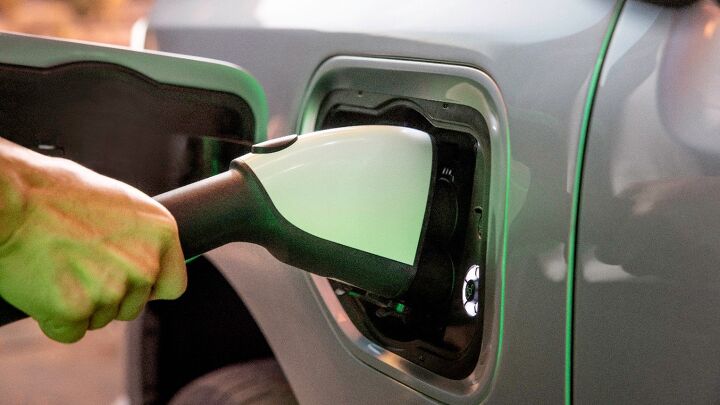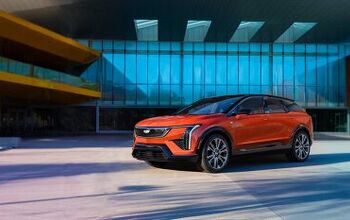Ford Scales Back Michigan Battery Plant Investments

Ford has said it will restart construction on the electric vehicle battery facility it’s building in Marshall, Michigan, after pausing work when the UAW strike kicked off a couple months ago. But the company has also announced that it would be “re-timing and resizing some investments.”
From Ford:
While we remain bullish on our long-term strategy for electric vehicles, we are re-timing and resizing some investments. As stated previously, we have been evaluating BlueOval Battery Park Michigan in Marshall.
We are pleased to confirm we are moving ahead with the Marshall project, consistent with the Ford+ plan for growth and value creation. However, we are right-sizing as we balance investment, growth, and profitability. The facility will now create more than 1,700 good-paying American jobs to produce a planned capacity of approximately 20 GWh.
We still expect BlueOval Battery Park Michigan to be the first of Ford’s battery plants of this kind when it begins producing LFP battery cells starting in 2026.
Ford had originally announced that the Blue Oval Battery Park would result in 2,500 jobs. The new 20 GwH capacity also shaves a fifth off the company’s initial estimate. Mark Truby, chief communications officer for Ford, noted this would likewise result in the $3.5 billion investment shrinking to roughly $2.2 billion.
“We’ve been studying this project for the past couple of months, and I think we’re all aware that EV adoption is growing, and we expect that to continue actually, but it’s not growing at the pace that I think ourselves and the industry had expected,” Truby was quoted by Automotive News as saying during a press call.
While the facility was a big deal for Michigan residents wanting to see more domestic automotive jobs, it’s also become a contentious issue on the national stage. Ford’s battery manufacturing is supposed to be done by licensing technology from China’s Contemporary Amperex Technology Co (CATL) and the issue has raised questions about national security and whether or not subsequent Ford products would be eligible for federal tax credits that are now tied to regional content requirements.
Though Ford has said its primary concerns stem from demand. It’s a claim one might be inclined to agree with if they’ve been following the market.
With so much government pressure to build EVs and assumptions that they would ultimately become more profitable than combustion vehicles, legacy manufacturers were eager to follow Tesla into the land of profitable electrification.
However, the public doesn’t appear sufficiently interested and the relevant technologies aren’t yet up to par. Tesla has remained the exception, rather than the rule. Meanwhile, EVs continue to be priced much higher than their combustion counterparts with demand being isolated primarily to metropolitan hubs and the wealthier surrounding suburbs. Segment growth is slowing and the industry is starting to act a little more cautious as the novelty of electric cars begins to wear off.
Dealers don’t seem to be particularly enthusiastic about electrification anymore either. Numerous brands (including Ford) have tied EV allocations to costly renovations that include on-site charging stations. The vehicles themselves are getting harder to move — something literally every dealer source I have has expressed to me this year. But we don’t technically need them to tell us, as the data speaks for itself. Both electric and combustion vehicles went into 2023 with a roughly 50-day supply. While that has remained more-or-less the case for gas-powered automobiles, the supply of battery vehicles has nearly doubled through October.
With the above in mind, Ford has likewise opted to scale back its electric vehicle certification program intended for dealers. The explanation given was that the Blue Oval needed to “adapt [its] overall EV strategy to the market and listen to dealer feedback.”
For specifics on the tweaked certification plan, check out Matthew Guy’s article covering the topic or some of our earlier pieces examining the legal issues surrounding the matter.
Expect to see media outlets bashing Ford for scaling back EV investments in the near term. You’ll also probably notice the stock market reacting unfavorably to the news for a time. In fact we saw the brand’s valuation slip a bit almost immediately after the two announcements were made. But Ford actually seems to be making the correct choice for itself here, even if Wall Street is blind to the fact. The automaker’s electric vehicle division is projected to lose $4.5 billion by the end of 2023 and wastes an estimated $36,000 on every EV it currently sells.
Investors have been on an impulsive tech binge for far too long and the fact remains that most automakers pressing forward with electrification haven’t seen great returns on their investment. As unfortunate as it is to see Blue Oval Battery Park being scaled back, it’s probably the correct move for the company to make at this juncture. Pragmatism may not be the best way to pump up the share price and tempt today's overeager investors. But it’s undoubtedly wiser than sticking with an existing plan that doesn’t seem to be working out for the broader industry.
[Image: Ford Motor Co.]
Become a TTAC insider. Get the latest news, features, TTAC takes, and everything else that gets to the truth about cars first by subscribing to our newsletter.

A staunch consumer advocate tracking industry trends and regulation. Before joining TTAC, Matt spent a decade working for marketing and research firms based in NYC. Clients included several of the world’s largest automakers, global tire brands, and aftermarket part suppliers. Dissatisfied with the corporate world and resentful of having to wear suits everyday, he pivoted to writing about cars. Since then, that man has become an ardent supporter of the right-to-repair movement, been interviewed on the auto industry by national radio broadcasts, driven more rental cars than anyone ever should, participated in amateur rallying events, and received the requisite minimum training as sanctioned by the SCCA. Handy with a wrench, Matt grew up surrounded by Detroit auto workers and managed to get a pizza delivery job before he was legally eligible. He later found himself driving box trucks through Manhattan, guaranteeing future sympathy for actual truckers. He continues to conduct research pertaining to the automotive sector as an independent contractor and has since moved back to his native Michigan, closer to where the cars are born. A contrarian, Matt claims to prefer understeer — stating that front and all-wheel drive vehicles cater best to his driving style.
More by Matt Posky
Latest Car Reviews
Read moreLatest Product Reviews
Read moreRecent Comments
- NJRide These are the Q1 Luxury division salesAudi 44,226Acura 30,373BMW 84,475Genesis 14,777Mercedes 66,000Lexus 78,471Infiniti 13,904Volvo 30,000*Tesla (maybe not luxury but relevant): 125,000?Lincoln 24,894Cadillac 35,451So Cadillac is now stuck as a second-tier player with names like Volvo. Even German 3rd wheel Audi is outselling them. Where to gain sales?Surprisingly a decline of Tesla could boost Cadillac EVs. Tesla sort of is now in the old Buick-Mercury upper middle of the market. If lets say the market stays the same, but another 15-20% leave Tesla I could see some going for a Caddy EV or hybrid, but is the division ready to meet them?In terms of the mainstream luxury brands, Lexus is probably a better benchmark than BMW. Lexus is basically doing a modern interpretation of what Cadillac/upscale Olds/Buick used to completely dominate. But Lexus' only downfall is the lack of emotion, something Cadillac at least used to be good at. The Escalade still has far more styling and brand ID than most of Lexus. So match Lexus' quality but out-do them on comfort and styling. Yes a lot of Lexus buyers may be Toyota or import loyal but there are a lot who are former GM buyers who would "come home" for a better product.In fact, that by and large is the Big 3's problem. In the 80s and 90s they would try to win back "import intenders" and this at least slowed the market share erosion. I feel like around 2000 they gave this up and resorted to a ton of gimmicks before the bankruptcies. So they have dropped from 66% to 37% of the market in a quarter century. Sure they have scaled down their presence and for the last 14 years preserved profit. But in the largest, most prosperous market in the world they are not leading. I mean who would think the Koreans could take almost 10% of the market? But they did because they built and structured products people wanted. (I also think the excess reliance on overseas assembly by the Big 3 hurts them vs more import brands building in US). But the domestics should really be at 60% of their home market and the fact that they are not speaks volumes. Cadillac should not be losing 2-1 to Lexus and BMW.
- Tassos Not my favorite Eldorados. Too much cowbell (fins), the gauges look poor for such an expensive car, the interior has too many shiny bits but does not scream "flagship luxury", and the white on red leather or whatever is rather loud for this car, while it might work in a Corvette. But do not despair, a couple more years and the exterior designs (at least) will sober up, the cowbells will be more discreet and the long, low and wide 60s designs are not far away. If only the interiors would be fit for the price point, and especially a few acres of real wood that also looked real.
- Slavuta So, the guys who still drive around in COVID masks are the smart ones???
- Slavuta Surprise? This is decades-old "news"
- Slavuta If I can get over lack of power - Civic 2L+MT. My son has Integra, which is Civic sport with Si Engine and MT, and slightly de-tuned suspension vs Si... nice car. Civic is just more comfortable car.


































Comments
Join the conversation
Hard to make a profit when electrons are the sole source of propulsion.
Oracle, your words are meaningful and appreciated. thank you.